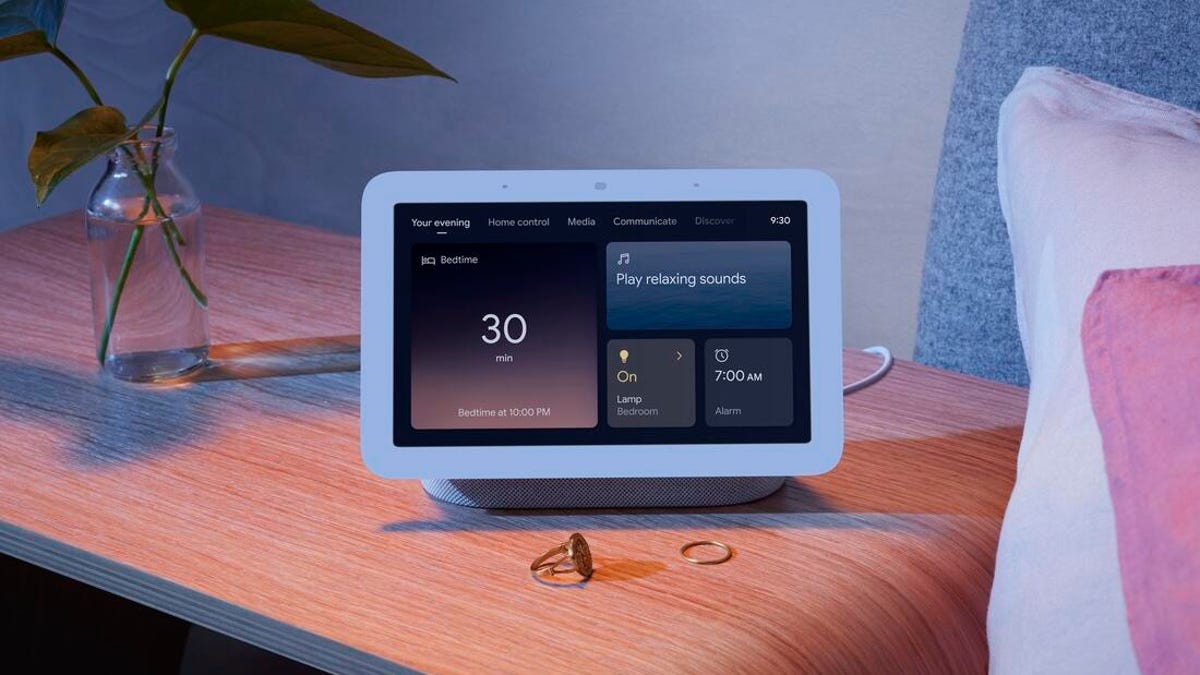 Why You Can Trust CNET
Why You Can Trust CNET The new Google Nest Hub tracks your sleep without wearables or cameras
Thanks to Google's Soli technology, Sleep Sensing is the headlining feature of the second-gen Nest Hub.

Not to be outdone by Amazon's moving, person-tracking Amazon Echo Show 10, Google's second-gen Nest Hub is available for preorder Tuesday with technology to sense your sleep habits from your nightstand. There aren't any cameras on the new Nest Hub. Instead, it uses miniature radar to monitor you at night, but that's not the only update to the company's popular smart display.
At first glance the new, $100 (£90, AU149) Nest Hub doesn't look much different than its predecessor. You'll get two new color options: sand and mist, in addition to the expected charcoal and chalk. Other noteworthy design changes include a new edgeless glass display and mechanical parts made with 54% recycled post-consumer plastic.
When it comes to audio, Google enhanced the bass on the new Nest Hub. Google notes that this new model is "based on" the same audio technology in the Nest Audio, Google's premium audio smart speaker released last year. The new Nest Hub also has 50% more bass.
You'll get streaming support for music, podcasts and audiobooks from YouTube Music, Spotify, Apple Music and Pandora. Supported video streaming services include Netflix, Disney Plus and YouTube TV. You'll find all the other standard smart display features you've come to expect from Google on this new display. There are a few new notable features, however.
Gesture control and smarts
Like the Nest Hub Max, the new Nest Hub will have gesture control, but unlike the max, the Nest Hub has no camera. This time, Google is using Motion Sense powered by Soli, a low-energy radar technology you might remember from some Pixel phones, to enable gesture control. With Motion Sense, you'll be able to pause and play content on the Nest Hub by tapping on the air in front of it.
Like the Nest Mini and Nest Audio, the new Nest Hub has a dedicated on-device machine learning chip. That means data is stored and processed locally on your device. The machine learning chip helps the Nest Hub learn common commands and respond to them faster. Currently, this is a US-only feature.
The new Nest Hub also includes a built-in Thread radio, a forward-looking nod to the work being of Project CHIP (Connected Home over IP), an effort involving Google, Amazon, Apple and the Zigbee Alliance to create a universal smart home standard.
Sleep Sensing with Soli
Google's big new feature on the new Nest Hub is Sleep Sensing. Google's new Nest Hub offers a way to track sleep without a wearable or a smart bed add-on. This opt-in feature uses the aforementioned Motion Sense tech. Sleep Sensing analyzes how the person closest to the display is sleeping, based on their movement and breathing. It can also detect coughing, snoring, as well as temperature and light changes via the hub's built-in microphones, light sensors and temperature sensors.
Sleep summaries are displayed on the device or in your Google Fit app for Android or iOS. Google will also suggest ways to improve sleep based on what the Nest Hub has observed. Google partnered with the American Academy of Sleep Medicine for sleep guidance and information.
Here's a quick peek at what Soli-powered Sleep Sensing is detecting while you snooze:
If Google watching (er, sensing) you sleep is a bit weird, you have some options. You can disable Sleep Sensing entirely. There's a visual indicator on the smart display that lets you know when Sleep Sensing is on. Motion Sense only detects motion, not specific bodies or faces, and your coughing and snoring audio data is only processed locally on the device. You have multiple controls to disable Sleep Sensing features, including a physical switch that physically disables the microphone. You can review or delete your sleep data at any point. Sleep data is not used for personalized ads.
Sleep Sensing will be available on the new Nest Hub as a free preview until next year. The team at Google didn't have any information to share on how the feature might be monetized in the future, but did say that they are looking for ways to integrate with Fitbit's sleep tracking features.
The second-gen Nest Hub is $100 (£90, AU149) and available for preorder now in the US, Canada, UK, Germany, France and Australia at the Google Store and other retailers. In-store and online availability is expected to begin March 30.

